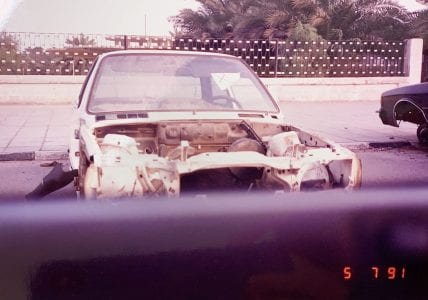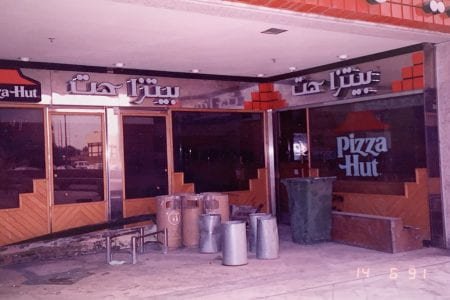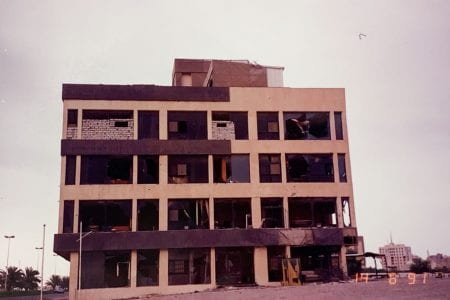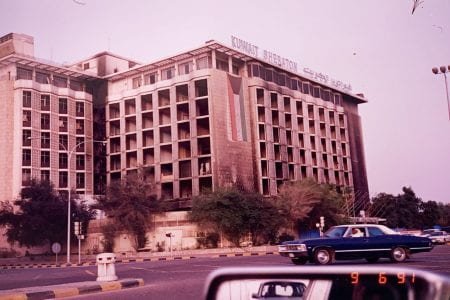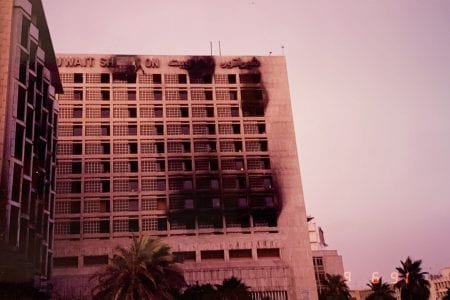Part 3 – Return to Kuwait
Parts were taken from this car parked on a residential street.
It took all of us quite some time for the news to sink in; that Kuwait had been liberated after seven months of occupation by a coalition of countries that came to assist Kuwait’s people. News crews sent back pictures of jubilation and devastation. Kuwaitis who stayed were finally coming out of their houses to welcome the liberators. The Kuwaiti flag flew for the first time since August 2nd. People didn’t have to fear for their lives if they showed their loyalty to Kuwait. Oil fires were burning in the south of Kuwait. The road to Mutla’a Ridge in the north was littered with burned out cars and trucks. There was so much to take in at once.
Soon families began making plans to reunite. Kuwaitis were scattered all over the world; UAE, Saudi Arabia, England, Spain, France, USA, Germany, Switzerland…We heard from my brother-in-law that the air was filled with smoke and there was a lot of infrastructure damage, but our homes had survived the destruction. The children, my husband and I were ecstatic to find out that my mother-in-law would be staying with us for two weeks in Spain and then spend some time in London with her other sons. We couldn’t wait to see her. My daughter was a newborn when we left in July 1990 and now she was almost ready to celebrate her first birthday.
My husband and I also discussed plans to return home. We were very concerned that my three year old would be affected by the smoke of the oil fires since he has asthma. We were also worried about furnishing our house which we had planned to do when we returned from vacation in September 1990. We decided to wait and see how long it would take the government (Emir, cabinet and parliament) to return from exile, and the predicted timeline for putting out the oil fires. By the end of April, it was clear that the oil fires would need months before a global group of specialist firefighters could end this environmental disaster. We also had to wait for commercial airlines to begin regular flights into Kuwait Airport.
A few weeks after Kuwait Airways (the national airline) made the announcement to begin flying from Malaga, Spain to Kuwait, we made our reservations to return home at the end of May. We packed our clothes and memories from the past ten months and closed up the apartment*, and said goodbye to many dear friends who supported us throughout the crisis. It was rather surreal and we weren’t sure what to expect when we landed.
It has been almost 30 years, but I will never forget what I saw when we entered Kuwait’s airspace. It was already evening; everything was dark in the desert except the glowing oil fires. I counted 1, 2, 3, 4 and then I stopped counting and I stopped looking out the window. I could feel my emotions as tears formed in my eyes (just the memory brings tears as I write this). When HE Sheikh Jaber Al Ahmed Al Sabah returned to Kuwait two weeks after the Liberation, he set foot on the tarmac, and knelt down to kiss the ground. That is how I felt when I landed. Grateful to be home, apprehensive about what I might see, but anxious to reunite with relatives and friends.
Perhaps it was a blessing that we arrived at night, so the true devastation and signs of the occupation, war, and its aftermath weren’t visible until we had time to rest after the journey. My daughter still had a crib in her room, but she was able to fall asleep. The boys eventually settled down after checking the basement where all their toys were to be sure everything was safe. My husband had decided to keep his 1988 Honda Civic at my mother in law’s house, where he thought it would be safe. When he picked it up after we returned, it had a bullet hole near the gas tank. I guess it wasn’t so safe on the main road to downtown where she lived…
The following days were a blur. We shopped for food, contacted family members to check on them, and took stock of what we still needed to buy for the house including a proper bed for my daughter. We also ventured out to see what damage had been done to our local community and to our favorite places. The first thing we noticed was the barbed wire on the median all along the Gulf Road and Corniche area. It was placed by the Iraqi troops because they assumed the initial assault by the Coalition would be from the sea. Then we drove downtown. The photos below show some of the damage.
As the first weeks passed, we heard more and more stories about houses and buildings that were used to hold prisoners and torture them to confess they were working with the Resistance. My mother-in-law told us that she had moved into our house after the first day since the area where her house is located, on a main road to Kuwait City, was deemed unsafe. The rest of the family members who remained in Kuwait for the duration met weekly at our house and watched out our kitchen window as cars and trucks filled with items stolen from government institutions, offices, the National Museum and private homes were transported to Iraq.
When the time came in August to decide which school to enroll my sons, my husband and I visited a private American curriculum school we had planned to enroll them in for the 1990-1991 school year which they missed. That seemed to be the logical choice. We wanted to see if the building and resources were ready since we had heard most of them had some type of damage. I wondered if students could start on time. What I found was a makeshift room without air conditioning and a facility that was definitely not ready for school to start in a few weeks. Even though the staff assured me it would be cleaned up, repaired, and supplies ordered in time, I was reluctant to register my sons. We decided to enroll the boys in a different private American school that seemed to have sustained less damage. We hoped it would reopen on time.
The oil fires were gradually extinguished. Each time, the sky went black as if it was the middle of the night. On those days, we kept the children inside. Early in the Fall of 1991, the government announced that the remaining fires would be extinguished by November. The environmental damage left birds and wildlife covered in oil. Asthma and other respiratory diseases increased. Eventually, everyone had to wash the outside of their houses because they were covered with black streaks. You couldn’t wear light or white clothing because it also became black.
Epilogue
A few anecdotes have stayed with me for the past 29 years and I’d like to share them.
1. I noticed that the number of cars on the road was much fewer than before we traveled. I found out later that the occupying forces stole cars from people at checkpoints and many had ended up in Iraq.
2. The first time I saw it happen, I wondered what was going on. The speed limit on highways in Kuwait is 120 km/hr (about 75 mph) and it is unusual to see cars pull over. Then I realized both drivers were reuniting after months of not seeing each other. This happened many times over the first year back. It happened in supermarkets and stores. The emotion was visible.
3. My sons had a very difficult time when we returned. The trauma they had suffered as a result of the disruption to their routines, not knowing or seeing their grandmother, and overhearing about the war had a definite effect on them. The house was new to them and they each had their own room. Although our room was nearby, there were many nights they couldn’t fall asleep or woke up after a nightmare. My four year old seemed to be affected the most. He asked about the soldiers and wanted to know if we were safe. And one day while the oil fires were making the sky dark in the middle of the afternoon he asked me, “Mama, do you know what Saddam did?” “No”, what did he do?,” I replied. “He made the sun go away.”
*We couldn’t bring ourselves to return to the apartment. There were too many memories; we sold it in 1994.
